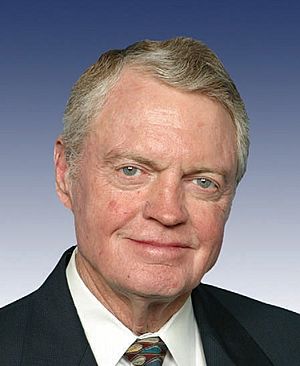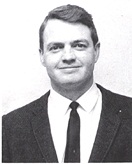Tom Osborne facts for kids
Quick facts for kids
Tom Osborne
|
|||||||
|---|---|---|---|---|---|---|---|
 |
|||||||
| Member of the U.S. House of Representatives from Nebraska's 3rd district |
|||||||
| In office January 3, 2001 – January 3, 2007 |
|||||||
| Preceded by | Bill Barrett | ||||||
| Succeeded by | Adrian Smith | ||||||
| Personal details | |||||||
| Born | February 23, 1937 Hastings, Nebraska, U.S. |
||||||
| Political party | Republican | ||||||
| Spouse |
Nancy Tederman
(m. 1962) |
||||||
| Children | 3 | ||||||
| Education | Hastings College (BA) University of Nebraska (MA, PhD) |
||||||
| Coaching career | |||||||
| Playing career | |||||||
| 1955–1958 | Hastings | ||||||
| 1959 | San Francisco 49ers | ||||||
| 1960–1961 | Washington Redskins | ||||||
| Position(s) | Quarterback, wide receiver | ||||||
| Coaching career (HC unless noted) | |||||||
| 1964–1968 | Nebraska (assistant) | ||||||
| 1969–1972 | Nebraska (OC) | ||||||
| 1973–1997 | Nebraska | ||||||
| Administrative career (AD unless noted) | |||||||
| 1979–1998 | Nebraska (assistant AD) | ||||||
| 2007–2013 | Nebraska | ||||||
| Head coaching record | |||||||
| Overall | 255–49–3 | ||||||
| Bowls | 12–13 | ||||||
| Accomplishments and honors | |||||||
| Championships | |||||||
3 National (1994, 1995, 1997)
7 Big Eight (1964–1966, 1969–1972) |
|||||||
| Awards | |||||||
Bobby Dodd Coach of the Year (1978)
2× Nebraska College Athlete of the Year (1958, 1959) Nebraska High School Athlete of the Year (1955) |
|||||||
| College Football Hall of Fame Inducted in 1999 (profile) |
|||||||
|
Football career |
|||||||
| Career NFL statistics | |||||||
|
|||||||
| Player stats at PFR | |||||||
| Scientific career | |||||||
| Fields | Educational psychology | ||||||
| Thesis | The Effects of Instructions on Situational Anxiety Level and Examination Performance (1965) | ||||||
| Doctoral advisors | Warren Bailer Robert Ross |
||||||
Thomas William Osborne (born February 23, 1937) is a famous American figure from Nebraska. He was a talented football player, a highly successful coach, a college sports leader, and even a politician. He is best known for being the head football coach for the Nebraska Cornhuskers for 25 seasons, from 1973 to 1997.
After being honored in the College Football Hall of Fame in 1999, Osborne was elected to Congress in 2000. He represented Nebraska's third district as a Republican. He served three terms until 2007. Later, he returned to the University of Nebraska–Lincoln to be the athletic director in 2007, retiring in 2013.
Osborne played college football as a quarterback and wide receiver at Hastings College. After a short career in the National Football League (NFL), he became an assistant coach at Nebraska. When he became head coach in 1973, he built one of the best college football programs ever. His teams were known for their powerful "I-formation" offense and advanced training programs. He retired with an amazing record of 255 wins, 49 losses, and 3 ties. His teams won 13 conference titles and three national championships. He coached many star players, including Heisman Trophy winner Mike Rozier.
Contents
Early Life and Education
Tom Osborne was born and grew up in Hastings, a town in central Nebraska. He was a fantastic athlete at Hastings High School. He excelled in football, basketball, and track. In 1955, during his senior year, he was named Nebraska High School Athlete of The Year.
He earned a bachelor's degree in history from Hastings College in 1959. Later, he continued his studies at the University of Nebraska. He received a master's degree in educational psychology in 1963 and a doctorate in 1965. Osborne also served in the Nebraska Army National Guard from 1960 to 1966.
Playing Career Highlights
At Hastings College, Osborne was the quarterback for the football team. He was the first male athlete in Nebraska to be named both the high school (1955) and college (1959) athlete of the year. He also received the Emil S. Liston Award in 1958. This award recognized outstanding junior basketball players who showed great athletic and academic success.
NFL Experience
The San Francisco 49ers drafted Osborne in 1959. However, he was released before playing in a regular season game.
The Washington Redskins then signed Osborne in 1960. He made his NFL debut on November 6, 1960. He played more in 1961, starting twelve games. He scored his first two touchdowns that season. His last NFL game was a victory for Washington over Dallas.
Coaching the Nebraska Cornhuskers
In 1962, Osborne joined the Nebraska coaching staff as an unpaid assistant. He only received meals at the athletic training table as payment. After a few challenging seasons, head coach Bob Devaney made Osborne the offensive coordinator in 1969. Osborne quickly changed the offense to a balanced attack using the "I formation."
This new offense helped the Cornhuskers win their first national championship in 1970. They beat LSU 17–12 in the Orange Bowl. Nebraska won another national title in 1971. They became the first champions to defeat the next three top teams in the final rankings.
Becoming Head Coach
Devaney stepped down as head coach after the 1972 season. He chose Osborne to take over. At 35 years old, Osborne became Nebraska's head coach. He held this position for 25 years until he retired after the 1997 season.
During his 25 years as head coach, Osborne's teams were incredibly consistent. They never won fewer than nine games in a season. They almost always finished in the top 15 of the final polls. Osborne's teams won national championships in 1994, 1995, and 1997. They also won or shared 13 conference championships. His record of 255 wins, 49 losses, and 3 ties gave him one of the best winning percentages in college football history. He reached 250 wins faster than any other coach in Division I-A.
Offensive and Defensive Style
Osborne's teams were famous for their strong running game and tough defense. The defense was known as the "Blackshirts," named after the black jerseys they wore in practice. Nebraska's "I-form" option attack led the nation in rushing many times. This was thanks to talented players like Mike Rozier and Lawrence Phillips. Osborne used dual-threat quarterbacks like Tommie Frazier and Scott Frost to run his option offense.
Memorable Games
One unforgettable moment was the 1984 Orange Bowl. Nebraska was undefeated and ranked No. 1. They scored a late touchdown against Miami to make the score 31–30. Instead of kicking for a tie, Osborne decided to go for a two-point conversion to win the game. However, the pass was blocked, and Miami won, earning their first national championship.
Nebraska lost another close championship game in the 1994 Orange Bowl. They were underdogs against Florida State. Nebraska led 16–15 with less than two minutes left, but Florida State scored to take the lead. Nebraska tried a last-second field goal, but it missed.
National Championship Wins
The next year, Osborne finally won his first national title as head coach. Nebraska defeated Miami in the Orange Bowl 24–17.
The following year, the Cornhuskers had an amazing season. They won every game by at least 14 points and broke many offensive records. Nebraska crushed Florida 62–24 in the 1996 Fiesta Bowl. This earned Osborne his second national championship. Many experts consider the 1995 Nebraska team to be one of the best college football teams ever.
Osborne announced his retirement late in the 1997 season. He chose Frank Solich to be his successor. In his final game, Nebraska won another national championship, beating Tennessee 42–17. In his last five seasons, Osborne's record was an incredible 60 wins and only 3 losses.
Coaching Honors
In 1995, Osborne received the Golden Plate Award. In 1998, the playing field at Memorial Stadium was renamed "Tom Osborne Field" in his honor. The stadium grew much larger during his time, showing Nebraska's rising fame.
Osborne was inducted into the College Football Hall of Fame in 1999. He also received the Jim Thorpe Lifetime Achievement Award in 2000. In 1999, ESPN named him the "coach of the decade" for the 1990s. A 2007 poll even called Osborne the "greatest college football coach of all time." In 2013, the NAIA Football National Championship trophy was named the "Tom Osborne Trophy." In 2018, he was inducted into the National High School Hall of Fame.
Athletic Director Role
From 1979 to 1998, Osborne was an assistant athletic director at Nebraska. In October 2007, he was named interim athletic director for the University of Nebraska. He later became the permanent athletic director.
In 2010, Osborne made a big decision for Nebraska sports. He ended Nebraska's long-standing relationship with the Big 12 Conference. He accepted an invitation for the school to join the Big Ten. This was a major change for the university's sports programs. Osborne retired from his role as athletic director on January 2, 2013.
Political Career
Serving in Congress
In early 2000, Osborne announced he would run for Congress in Nebraska's 3rd District. He ran as a Republican. Even though he had not lived in the district regularly for many years, his huge popularity in the state helped him win easily. He won the Republican primary and then the general election with 83 percent of the vote. He was reelected in 2002 and 2004.
In Congress, Osborne was known for his moderate to conservative voting record. After his time in Congress, President George W. Bush appointed him to a board in 2007, but he resigned in 2008.
Running for Governor
In 2006, Osborne ran for Governor of Nebraska. He challenged the current governor, Dave Heineman, in the Republican primary. Many people thought Osborne would win because of his popularity. However, Heineman won the primary election with 49 percent of the votes, compared to Osborne's 45 percent.
Images for kids



